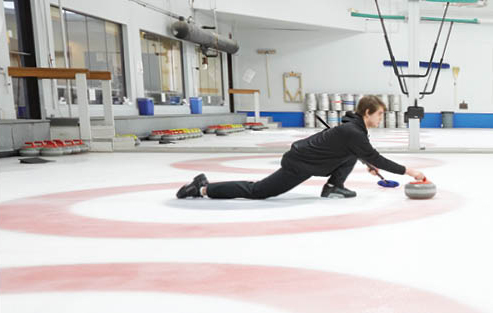When one thinks of Minnesota sports, it’s often the frozen lake pastimes that come to mind; hockey and ice-fishing serve as the renowned recreational activites of every fleece jacket-wearing northerner. Yet the capital city boasts a very specific sports legacy that rivals them both in richness, length and notoriety—and it can be tied directly to one 104-year old Selby Avenue institution: the St. Paul Curling Club (SPCC).
The roots of the club began in the late 1800s, with the frozen Mississippi serving as the playing ground for the Scottish sport. It didn’t take long for the sport to grow popular enough to need a home base, and when the iconic club opened its doors in 1912, it was a playground for the who’s who of St. Paul. Summit Avenue men with last names that have far outlived them— such as Bremer and Ordway—filled the rosters. Today, it is the largest curling club in North America, and arguably the largest club in the world.
The sport is simple in nature; it revolves around two teams competing by sliding 42-pound stones across the ice in the hopes of stopping them on a target under the ice. One member slides the stone in a spinning, or “curling” motion down the ice—inspiring the sport’s name—while other team members use brooms to quickly sweep ahead of the stone to keep it moving at its pace. The team with the stones closest to the targets at the end of the match is named the winner. While its simplicity may play a key role in attracting newcomers, it’s the culture stemming from its rich history that keeps players coming back.
For SPCC general manager Scott Clasen and president Tim McMahon, as well as many SPCC members, curling is a family rite. Both are Rosevillle-hailing third generation curlers at SPCC. For Clasen the tradition is even reaching a fourth generation as his two children curl competitively at the club.
McMahon is the son of one of the oldest members in the club, 86-year-old Chuck McMahon, who still curls four times a week. So it was no surprise that twenty years after joining the family tradition, Tim McMahon decided to document the decorated history of the club by co-writing a book about it. “Five years before our 100th anniversary in 2012, we knew as a board that we wanted to start gathering all the historical information,” McMahon says. “We had no clue about the extent of what we would find. We have every roster that has ever existed archived.” Those old rosters add up to an impressive statistic—there have been 8,500 members of the club to-date.
But the story of the St. Paul Curling Club is not gilded all the way through; there are numerous times over the past century that the club was close to shutting its doors. In the 1920s, President Adams Lawson mortgaged his own business to keep the club alive. Half a century later in the 1970s, the downturn of Selby Avenue and the opening of an Arden Hills curling club brought on the lowest member number in the club’s history at fewer than 200 members. It was the decision to gather a group of loyal volunteers, later dubbed “the Tuesday night work club,” to meet every Tuesday for a couple hours to put some elbow grease into reviving the space.
And the St. Paul community is grateful for that elbow grease—today, the club has 1,150 active members in 20 leagues. On any given weekend between October and May, there’s a tournament, or “bonspiel,” as it is referred to within the sport, drawing women, men and children alike to the eight sheets of ice at SPCC. According to Clasen, there has been a waiting list to join SPCC for the past few years, but there are ample opportunities for newcomers to come in and learn the sport, and spectators who want to check out the games or the club facility itself are always welcome.

After all, the club serves as an important historic landmark in St. Paul. Clasen and club leaders throughout the years have worked hard to maintain the integrity of the original architecture and experience through rounds of renovations and improvements. Beyond the ice itself, visitors may find themselves drawn to the beloved cedar-beamed club room upstairs. The spirit of this club room pre-dates the curling club, as it once served as a sophisticated social club that allowed St. Paul residents to pull directly up in their horse and buggy. When the club moved in, it became a refuge for men to drink together after curling. “For a good part of the club’s early history, it was truly exclusively a good old boys’ room,” says McMahon.
But it wouldn’t continue as a boys-only club forever. In 1952 the club began to allow women to curl, and the first all-female team, the Bonnie Spielers, was born. Paula Dunlop Arnold, the granddaughter of one of the club’s founders, Ker D. Dunlop, grew up watching curling, and was on that original team. “We definitely tried to recruit the wives and sisters of curlers…women who had been around the sport,” says Dunlop. “Sure, the old boys would come down and chuckle and tell us what we were doing wrong, but we’ve always had a good group.” Today, the Bonnie Spielers live on as a separate league within the SPCC along with another all-female league, The Cairn Lassies, which Dunlop also played a role in founding. At age 89, Dunlop is the oldest member in the SPCC, and she still gets on the ice once a week. “I just love it. I want to do it as long as I am physically able,” says Dunlop.
While Dunlop’s legacy is incredible, growing up in the SPCC and subsequently never leaving is a commonplace practice thanks to the Juniors program. In the 1950s, the late Mike Rugg began the program, welcoming members as young as 8 years old to the club to learn the sport. “Now, more than 60 years later, we have incredible talent coming out of the SPCC and competing nationally because they were able to get exposure at a young age,” says McMahon.
Mike Farbelow is an example of one of these homegrown prodigies. Farbelow was born in St. Paul and started curling at the club at the age of 14. Since then, he has gone on to make four appearances at the U.S. National Curling Championships, including a silver-medal finish in the 2010 championships. Through all of his travels, Farbelow ranks SPCC in a category of its own when compared to other national clubs. “The urban setting allows us to have a really vibrant membership made up of all genders, ages and socioeconomic backgrounds,” says Farbelow. “It’s just a great mix of folks who come ready to curl.”
It’s also not uncommon to see whole families engaging in the sport together. “Even though the club is large, it really has a family-friendly atmosphere,” says McMahon. “There’s an openness and a neighborly manner among curlers that just makes this place really special.” On any given night the once boys-only club room hosts post-spiel beer toasts, bites to eat from the full kitchen and card games among all ages. “There’s such a sense of belonging here,” says McMahon. “Even for those who are new to the sport. That sort of inclusion is just part of the game.”
More than a century after its start, the key to the legacy and love that surrounds the SPCC can be demonstrated through a common curling tradition: “stacking the brooms.” At any point during the match, opposing teams can decide to throw their brooms in a pile and leave the ice in favor of taking a break together in a social setting before returning to finish. Clasen, McMahon, Dunlop and Farbelow all agree—it’s this camaraderie and sportsmanship that set the sport apart. “Whether it’s the St. Paul neighborhoods, families or friends—this sport has always been about coming together,” says Clasen. “We’re all about growing the sport and sharing this experience.”









